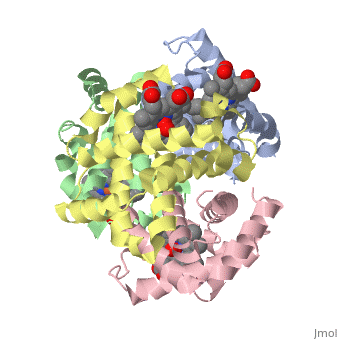Sandbox Reserved 1395
From Proteopedia
(Difference between revisions)
| (3 intermediate revisions not shown.) | |||
| Line 6: | Line 6: | ||
== Function == | == Function == | ||
| - | Hemoglobin | + | Hemoglobin in vertebrates carries oxygen from the respiratory organs (lungs and gills) to the rest of the body tissues. About 270 million hemoglobin molecules reside in each red blood cells, which are circulated to use it to carry oxygen around the bodies of vertebrates. Hemoglobin is also what causes their blood to appear red. |
==Structural Highlights== | ==Structural Highlights== | ||
| Line 18: | Line 18: | ||
'''Sickle Cell Anemia''' | '''Sickle Cell Anemia''' | ||
| - | For the most part, amino acid sequences can be slightly different, but sometimes a change in the sequence can have a large impact. For example, in sickle cell anemia, glutamate 6 in the beta chain is mutated to valine, resulting in a structural change that allows hemoglobin to stick to each other and create stiff fibers, which creates the sickle shape in blood cells. These fibers are helpful because the malaria virus cannot live in blood cells with them, but can also lead to rupture of the blood cell, causing a loss of hemoglobin. | + | For the most part, amino acid sequences can be slightly different, but sometimes a change in the sequence can have a large impact. For example, in sickle cell anemia, glutamate 6 in the beta chain is mutated to valine, resulting in a structural change that allows hemoglobin to stick to each other and create stiff fibers, which creates the sickle shape in blood cells. These fibers are helpful because the malaria virus cannot live in blood cells with them, but can also lead to rupture of the blood cell, causing a loss of hemoglobin. The sickle cell mutation typically affects one of the <scene name='77/777715/Beta_chain/3'>beta chains</scene>, causing an abnormal beta chain called Hbs. |
'''Thalassemia''' | '''Thalassemia''' | ||
| - | This is another genetic disease involving hemoglobin. Here, there is some sort of error in the production of beta proteins. In normal hemoglobin, there is two alpha proteins and two beta, but when thalassemia occurs, there may be low levels or no beta proteins, decreasing the amount of functional hemoglobin and therefore supplies of red blood cells, often causing anemia. | + | This is another genetic disease involving hemoglobin. Here, there is some sort of error in the production of beta proteins. In normal hemoglobin, there is two alpha proteins and two beta, but when thalassemia occurs, there may be low levels or no <scene name='77/777715/Beta_chain/1'>beta proteins</scene>, decreasing the amount of functional hemoglobin and therefore supplies of red blood cells, often causing anemia. |
| - | + | ||
| - | + | ||
| - | + | ||
== References == | == References == | ||
<references/> | <references/> | ||
| + | https://ghr.nlm.nih.gov/condition/beta-thalassemia#genes | ||
| + | http://pdb101.rcsb.org/motm/41 | ||
| + | https://ghr.nlm.nih.gov/condition/sickle-cell-disease#genes | ||
Current revision
| This Sandbox is Reserved from January through July 31, 2018 for use in the course HLSC322: Principles of Genetics and Genomics taught by Genevieve Houston-Ludlam at the University of Maryland, College Park, USA. This reservation includes Sandbox Reserved 1311 through Sandbox Reserved 1430. |
To get started:
More help: Help:Editing |
Hemoglobin
| |||||||||||

